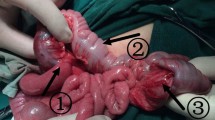Abstract
Background
Ileocolic intussusception occurs when the terminal ileum “telescopes” into the colon. We observed that ileocolic intussusception lengths are similar regardless of location in the colon.
Objective
To examine the uniformity of ileocolic intussusception length and its relationship to colon location, symptom duration and reducibility.
Materials and methods
We retrospectively reviewed ultrasound-diagnosed pediatric ileocolic intussusceptions initially treated with pneumatic reduction at the Mayo Clinic or Texas Children’s Hospital. We recorded demographic, imaging and surgical findings including age, gender, symptom duration, location of the ileocolic intussusception, reducibility with air enema and, if fluoroscopically irreducible, surgical findings.
Results
We identified 119 ileocolic intussusceptions (64% boys), with 81% in the right colon. There was no significant relationship between ileocolic intussusception length and colon location (P=0.15), nor ileocolic intussusception length and symptom duration (P=0.36). Ileocolic intussusceptions were more distal with increasing symptom duration (P=0.016). Successful reductions were unrelated to symptom duration (P=0.84) but were more likely with proximal versus distal locations (P=0.02).
Conclusion
Ileocolic intussusception lengths are relatively uniform regardless of location along the course of the colon where they present. Our findings suggest that most of the apparent distal propagation of ileocolic intussusceptions is not caused by increasing telescoping of small bowel across the ileocecal valve but rather by foreshortening of the right colon. This implies poor cecal fixation and confirms fluoroscopic and surgical observations of cecal displacement from the right lower quadrant with ileocolic intussusceptions. The movement of the leading edge of the ileocolic intussusception during reduction is first due to “relocating” the cecum into the right lower quadrant after which the reduction of small bowel back across the ileocecal valve then occurs.






Similar content being viewed by others
Change history
25 January 2019
In this article, the fourth author’s name is misspelled. The correct spelling, as shown above, should be “Nadia F. Mahmood.”
References
Katz ME, Kolm P (1992) Intussusception reduction 1991: an international survey of pediatric radiologists. Pediatr Radiol 22:318–322
Hannon E, Williams R, Allan R, Okoye B (2014) UK intussusception audit: a national survey of practice and audit of reduction rates. Clin Radiol 69:344–349
Edwards EA, Pigg N, Courtier J et al (2017) Intussusception: past, present and future. Pediatr Radiol 47:1101–1108
Gilsanz V (1984) Displacement of the appendix in intussusception. AJR Am J Roentgenol 142:407–408
Berdon WE (1995) The diagnosis of malrotation and volvulus in the older child and adult: a trap for radiologists. Pediatr Radiol 25:101–103
O’Neil J (2003) Chapter 54: intussusception. In: O’Neil J, Grosfeld J, Fonkalsrud E (eds) Principles of pediatric surgery. Mosby, St. Louis, pp 527–528
Waugh GE (1911) Referred penile pain in intussusception, with notes of three cases. Lancet 177:1492–1494
Brereton RJ, Taylor B, Hall CM (1986) Intussusception and intestinal malrotation in infants: Waugh's syndrome. Br J Surg 73:55–57
Cera SM (2008) Intestinal intussusception. Clin Colon Rectal Surg 21:106–113
Columbini PM, Scholz S (2012) Chapter 85: intussusception in pediatric surgery. In: Coran AG, Adzick NS, Krummel TM et al (eds) Pediatric surgery e-book. Elsevier, Philadelphia, pp 1093–1110
Lampl BS, Glaab J, Ayyala RS et al (2017) Is intussusception a middle-of-the-night emergency? Pediatr Emerg Care. https://doi.org/10.1097/PEC.0000000000001246
Tareen F, Ryan S, Avanzini S et al (2011) Does the length of the history influence the outcome of pneumatic reduction of intussusception in children? Pediatr Surg Int 27:587–589
Flaum V, Schneider A, Gomes Ferreira C et al (2016) Twenty years' experience for reduction of ileocolic intussusceptions by saline enema under sonography control. J Pediatr Surg 51:179–182
Saxton V, Katz M, Phelan E, Beasley SW (1994) Intussusception: a repeat delayed gas enema increases the nonoperative reduction rate. J Pediatr Surg 29:588–589
Sandler A, Ein S, Connolly B et al (1999) Unsuccessful air-enema reduction of intussusception: is a second attempt worthwhile? Pediatr Surg Int 15:214–216
Acknowledgments
The authors acknowledge the manuscript preparation assistance of Sonia Watson, PhD.
Author information
Authors and Affiliations
Corresponding author
Ethics declarations
Conflicts of interest
None
Rights and permissions
About this article
Cite this article
Binkovitz, L.A., Kolbe, A.B., Orth, R.C. et al. Pediatric ileocolic intussusception: new observations and unexpected implications. Pediatr Radiol 49, 76–81 (2019). https://doi.org/10.1007/s00247-018-4259-9
Received:
Revised:
Accepted:
Published:
Issue Date:
DOI: https://doi.org/10.1007/s00247-018-4259-9




